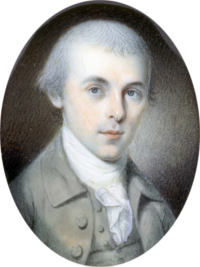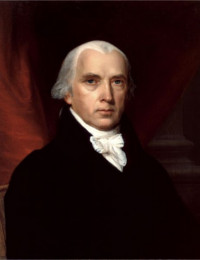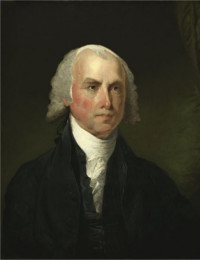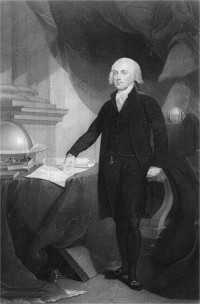James Madison, who was the fourth president of the United States, was a devoted patriot, co-author of the Federalist Papers, and came to be known as the Father of the Constitution. He was born March 16, 1751 in Port Conway, Virginia, the oldest of five children in his family. His parents had a few other children, but they had died as infants or been stillborn, so James was the eldest. He grew up in Port Conway on his father’s plantation, and when he became old enough to be educated, he studied under Donald Robertson, a Scottish teacher to the children of wealthy plantation owners.

James Madison, age 32, by Charles Wilson Peale
After he had completed his studies, he went to college at Princeton, at the time called The College of New Jersey. In college, he became close friends and roommates with Phillip Freneau, the “poet of the revolution”. Madison also hoped to be wed to Freneau’s favorite sister, Mary, but she refused all of his proposals. She fancied him, however she believed that the only way a woman could be recognized for her intellect and skills was to remain single and make a living for herself.
During his college years, Madison had founded the American Whig Society just to spite another student, and during that time he discovered a passion for law. Thus when he graduated, he began to study law. When the revolution came about Madison was still a young man, but was elected to Virginia’s legislature and became the youngest member of the Continental Congress. He followed Thomas Jefferson very closely, and people called him Jefferson’s protégé.

This painting of James Madison is by John Vanderlyn. It was commissioned by James Monroe, his successor as president and fellow Founding Father. It was completed in 1816.
Madison witnessed the persecution of two Baptist preachers by the British for preaching without a license, and it appalled him. As a result, with a preacher named Elijah Craig, he began to make a new law for America that every man would have freedom of religion, that he may worship his god any way he please. Later on, this case helped shape many of the ideas for the writing of the Constitution and the Bill of Rights.
In his time at Congress, as the youngest member, Madison was considered a legislative work horse to the other men. He was sent out to do many of the harder jobs that others did not want to take care of. On one such mission he persuaded Virginia to give up the NorthWest territory to the Congress. This was the first land that belonged to the American government. The congress then made a law prohibiting slavery north of the Ohio River; however owners who had already settled there with their slaves were allowed to keep them. This was the first government act in America against slavery.
After the war, Madison was a huge part in establishing the new American government. He helped write the constitution and the bill of rights and is called the father of both. However, when he heard this name, he was quick to shoot it down and let everyone know that they were the offspring of more than just one mind.

James Madison, painted around 1821, public domain image
As time went on, he grew more and more frustrated with what he called “excessive democracy”. He saw that the delegates would do whatever was the popular vote of their state, whether or not it was in the best interest of the state as whole. He was also offended that the government would condone a system with paper money, but most of all it infuriated him that they would not allow diplomatic immunity to ambassadors from other countries while they were on American soil. He believed that their excessively democratic system would lead to a social decay.
James Madison was elected the fourth U.S. president in 1809. He had a mostly uneventful presidency, keeping in effect the practices of the presidents before him until Napoleon started the war of 1812. He (Napoleon) intended to take Great Britain by starving them out. It went fairly well at first, as he forced most of the other European countries to discontinue all trade with Britain. This worked until Portugal refused to comply with Napoleon’s wishes. This defiance made Portugal and Spain primary targets for Napoleon, thus giving the British a large advantage in the war. The British then started direct combat on the sea with Napoleon.

The British had stopped Napoleon from trading with the Native American tribes in the U.S., and seeing the lack, they decided to take advantage of this trade route. The Americans were immediately offended with the British presence in their new country, and they saw it as an attack on American sovereignty. This made the citizens extremely angry, and the Americans decided to attack the British for a “second war of independence.”
President James Madison had a new “War Hawk” Congress put into effect, and started working on rounding up an army. All the odds were against them, and the idea of attacking the British in their position was very poorly thought-out. However, they marched into battle with inadequate supplies, generals, soldiers, and even a slip house.
The British did not pay too much attention to the Americans at first, due to the much larger threat of the French. However, this only made the Americans angrier, and insulted their pride. When the British finally started paying attention to the Americans (after the threat of Napoleon was pretty much gone), they were at a clear advantage. The Americans fooely won the war with the British, which last until 1815. If they’d lost that war, the British would have reclaimed their control of the colonies. However, the Americans did win the war, and they finally felt like they proved themselves as a world power.
James Madison concluded the second term of his presidency in 1817. After his presidency he retired and lived a much quieter life until he died on June 28, 1836.


